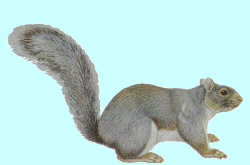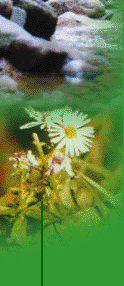|
There are over 365 species of squirrels in seven families. They include the tree squirrel, ground squirrel, and flying squirrel. There are also many other squirrel-like mammals such as the gopher, ground hog, and prairie dog. Squirrels become most active in late winter during mating season. Males will chase after females, as well as chase off other suitors. The chasing is a sort of ritual and occurs in the tree tops at top speeds.
The gestation period of the squirrel varies from 33 days in smaller species, to up to 60 days for larger species such as the common gray. Squirrels are usually born early in the spring. Four is the average litter number. This number can vary with climate and location. In mid-summer a second litter may occur if there is an adequate food supply.
A baby squirrel ways approximately 1 oz. at birth, and is 1 in. long. They do not have hair or teeth and are virtually blind for the first six to eight weeks of life.
Squirrels come in many different colors. Shades of gray and brown are most common. There are also squirrels that are completely white or black, but both are variations on the gray squirrel. The Red squirrel may have an all black coat, while the Kaibab squirrel has a black body with a white tail.
Squirrels are most active in the summer, two to three hours after sunrise, and rest in the afternoon. They will resume activity again two hours before sunset. The squirrel will retire to its nest well before dark, and will rarely leave the nest after. In the winter, the squirrel will complete its activities between dawn and mid-day, and will remain in and around the nest until the next day. The squirrel does not hibernate in winter, but may stick around the nest for several days to conserve body heat.
Adult squirrels usually live alone but will live with other squirrels during periods of severe cold to conserve body heat. After the cold is over the other squirrels are quickly on their way.
Squirrel eyes are located high on both sides of the head. This allows them a wide field of vision without turning their head. A squirrel's brain is about the size of a walnut. The sweat glands of a squirrel are located on their feet, between the foot pads and on their paws between the toes. A hot or excited squirrel will leave wet tracks on a dry surface.
Squirrels communicate through a series of chirps. The frequency, and the duration of the notes communicate everything from laughter to alarm. Their frequency range is normally between .01 KHz. and 10 KHz.(kilohertz). These sounds when combined with tail gestures form the basis of squirrel communication.
The squirrel's erratic path while crossing a street is an attempt to confuse the oncoming vehicle, thereby causing it to change direction. This is obviously the squirrels biggest and often last mistake.
 |
 |
|

Gray Squirrel (Sciurus Carolinensis) |
Squirrel of The Month
The gray squirrel is 15" long and weighs about 1lb. Its diet consists of nuts, seeds, and fruit. They will eat scraps from the trash, including bread, meat, and snack food. They are the most common urban squirrels. Most of them do not reach their first birthday, not due to predators, but automobiles.
|
|  |
 |
|  |
 |
Squirrel Trivia
Do squirrels hibernate?
No, squirrels do not hibernate. Tree squirrels are active all year round. You may not see them as often in the winter because they stay in their nests for most of the day to conserve body heat.
|
 |  |
|




